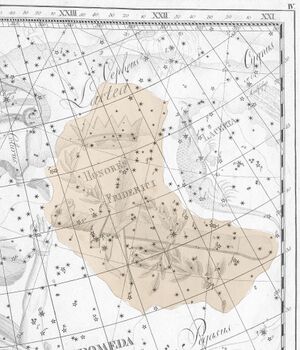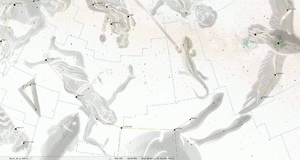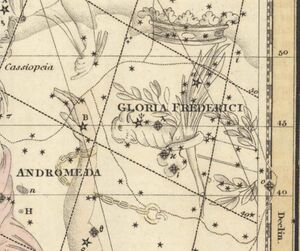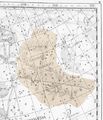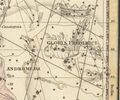Honores Friderici
This obsolete constellation was invented in France, but became more famous after a renaming in Prussia. In both cases, the constellation depicts some symbols of honour and admiration for the contemporary ruler. The Latin term "Honores" means honour. As a political constellation, it became obsolete with the global standardization of constellations by the IAU in the 1920s.
Etymology and History
Bode's creation
The young mathematician Johann E. Bode (1747-1826) named a constellation in honour of the Prussian king in German "Friedrichsehre", which can be translated as "honour of Frederick", the deceased king of Prussia. In Bode's greatest atlas, the Uranographia (1801), the constellation is depicted as a sceptre with laurel branches and a ribbon, and a crown on top. It's a named area without any recognizable star pattern.
The same depiction is inserted in the 1805 edition of his earlier (smaller) celestial atlas in German, first published in 1782 (without this new constellation). In this book, "Anleitung zur Kenntniß des gestirnten Himmels - Vorstellung der Gestirne", Bode's target group is the broad public and not an academic audience. He adds the new constellation in the Andromeda map (Tafel III) but not in the Pegasus map (Tafel XII). On Tafel XII, Andromeda's right arm is drawn as described in Ptolemy's Almagest with the hand marked by the stars κ, λ, ι And. In contrast, on Tafel III which shows the new constellation, Andromeda's arm had to be moved eastwards.
In the first edition of his 1782 celestial atlas, Bode does not yet have the new constellation "Friedrichsehre". He only adds it in a later edition: the third edition (1805) appeared after the showpiece "Uranographia" in 1801. There, it was added to the headline "Triangel" (Triangulum) which is the wrong place, as Triangulum is southeast of Andromeda and his new constellation northwest of her.
| id | description | ident. | Vmag |
|---|---|---|---|
| 1 | westernmore in the head of the scepter | λ And | 3.82 |
| 2 | south of the head of the scepter, at the ribbon | κ And | 4.14 |
| 3 | next to the one south of the head of the scepter | ι And | 4.29 |
| 4 | in the head of the scepter | ψ And | 4.966 |
| 5 | at the end of the scepter | ο And | 3.62 |
| 6 | above the one at the end of the scepter | 2 And | 5.25 |
| 7 | the southern one of the two in the laurel branch at the end of the scepter | HIP 113802 | 6.42 |
| 8 | the northern one of them | HIP 113750 | 6.43 |
| 9 | at the tip of the leaf of the laurel branch at the end of the scepter | 4 And | 5.294 |
| 10 | at the ribbon next to the laurel branch at the end of the scepter | HIP 114981 | 6.4 |
| 11 | the one in the middle bottom part of the scepter | 6 And | 5.9 |
| 12 | the one where the feather leaf intersects the scepter | 13 And | 5.736 |
| 13 | at the end of the ribbon in the middle of the scepter | 15 And | 5.563 |
| 14 | at the end of the feather leaf | 14 And | 5.2 |
| 15 | the lonely one under the entire ornament | 12 And | 5.765 |
| 16 | westernmost in the feather leaf | 3 And = HIP 113919 | 4.6 |
| 17 | in the feather leaf | 5 And | 5.65 |
| 18 | in the feather leaf | 7 And | 4.5 |
| 19 | in the feather leaf | 8 And | 4.8 |
| 20 | in the feather leaf | 11 And | 5.4 |
| 21 | lower in the northernmost laurel branch | HIP 115996 | 6.15 |
| 22 | upper one in the northernmost laurel branch | 18 And | 5.35 |
Marked only in the Uranographia (not enough stars in the 1805 edition)
| id | description | ident. | Vmag |
|---|---|---|---|
| HIP 116940 | |||
| HIP 116941 | |||
| HIP116582 A | |||
| HIP 117340 A | |||
| crown | HIP 112731 | ||
| crown | HIP 113561 | ||
| crown | HIP 114622 | ||
| crown | HIP 114924 | ||
| crown | HIP 114162 | ||
| crown | HIP 113501 | ||
| ... | |||
Bode's predecessor Royer
Although Bode does not mention any sources, it is frequently pointed out that Bode's constellation likely was inspired by the earlier French invention of the constellation "Sceptrum" by Augustin Royer who lived in the time of Louis XIV.[1] Royer had dedicated two constellations in honour to his king, the "Sun King" of the absolutist monarchy: the French national emblem, the Lily (Lilium, today surviving in the star name Lilii Borea), and the Sceptrum et Manus Iustitiae (Latin for "The Scepter and the Hand of Justice"). As Royer had obtained his star coordinates from the Carthusian monk Anthelme Voituret (1618-1683), whose work is not independently preserved but only in Royer's correction for the equinox 1700, it remains unknown who of the two invented this constellation.[2]
Royer's constellation was larger than Bode's as it also covered the area of Lacerta. Royer seems to have covered the empty area first, but in Bode's time Hevelius's influencial atlas had defined the Lizard there, and Bode had to shift Andromeda's arm to make room for the sceptrum.
| id | description | ident. | Vmag |
|---|---|---|---|
| 1 | the one in the middle of the hand | α Lac | 3.77 |
| 2 | the one at the pointer finger of the hand | β Lac | 4.4 |
| 3 | the one where the thumb joins | 4 Lac | 4.55 |
| 4 | the one where the little finger joins | 9 Lac | 4.6 |
| 5 | the eastern one of the three in the scepter | 8 And | 4.8 |
| 6 | the middle one of them | 7 And | 4.5 |
| 7 | the western one of them | 3 And | 4.6 |
| 8 | the one at the root of the hand | 5 Lac | 4.3 |
| 9 | the eastern one at the intersection of scepter and hand | 11 Lac | 4.5 |
| 10 | the western one of them | 6 lac | 4.5 |
| 11 | the northern one of the two at the end of the scepter | HIP 109754 | 4.65 |
| 12 | the southern one of them | 1 Lac | 4.1 |
| 13 | the easternmost at the ribbon around the intersection | 15 Lac | 4.95 |
| 14 | the southern one of the two at bottom part of the stick of the hand | 10 Lac | 4.85 |
| 15 | the northern one of them | 8 Lac | 5.65 |
| 16 | the one at the ribbon, west of the hand | 2 Lac | 4.55 |
| 17 | the one at the western end of this ribbon | HIP 109102 | 5.05 |
Variant: Gloria
Ian Ridpath[1] pointed out that the international derivatives of Bode's Uranographia (1801) occasionally offered the variant "Gloria" instead of "Honores". Jamieson’s atlas named it Gloria Frederici, as did Urania's Mirror, while Burritt had the slightly different Gloria Frederica (both Burritt and Urania’s Mirror copied from Jamieson, who in turn relied on Bode as primary source[3]).
Transformation and Variants
Mythology
IAU Working Group on Star Names
In 2023, it was suggested to keep the memory of this obsolete constellation by naming a star "Honores" or "Gloria" without any political reference - neither the French nor the German. The general concept of "honour" or "glory" of all humans who support science - might that be as taxpayers, political rulers or patrons - could be honoured with this star name. The brightest stars of the obsolete constellation are λ And (3.8 mag) κ And (4.15 mag) ι And (4.25 mag) and ο And (3.7 mag). λ And has an ancient Babylonian star name (Asidu ša U8.KA.DU8.A), and κ, ι And form the hand of Andromeda in the Almagest. Thus, ο And (3.7 mag) is recommended for the name "Honores".
WGSN decided ... in the IAU-CSN.
Weblinks
Reference
- References (general)
- References (early modern)
- Ian Ridpath's website (Star Tales )
- ↑ 1.0 1.1 Ian Ridpath, Star Tales (1988, Online Edition).
- ↑ Warner, D. (1979). The Sky Explored - Celestial Cartography 1500-1800. Theatrum Orbis Terrarum, Amsterdam.
- ↑ Kanas, Nick (2012, 2019). Star Maps. History, Artistry, and Cartography, Springer Science & Business Media, ISBN 1461409179, 9781461409175 (online version).
